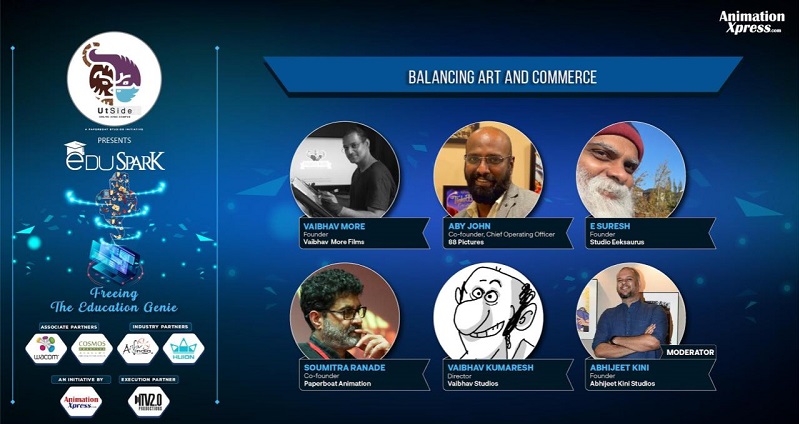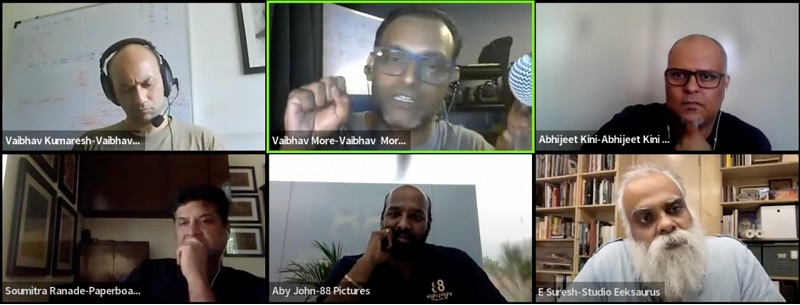On its second day, EduSpark Summit witnessed an enriching panel discussion touching upon various aspects of the commercial viability of creative content. The panel elaborated upon the need to train the artists first, lay the foundation and give importance to the creativity which will automatically help them earn good money. One should also master the game of delivering for the audience.
The main aim of the ‘Balancing Art and Commerce’ was to throw light on how the creative artists need to ensure their creativity amidst updating themselves with the ever-changing technology and learning new types of software and understanding how to make content creation commercially viable.
The panel included Vaibhav More Films founder Vaibhav More, 88 Pictures co-founder, chief operating officer Aby John, Studio Eeksaurus founder E Suresh, Paperboat Design Studios co-founder Soumitra Ranade and Vaibhav Studios director Vaibhav Kumaresh. The session was moderated by Abhijeet Kini Studios founder Abhijeet Kini.
National Film Award winning animation filmmaker E Suresh stresses on the fact that while at the institute one should focus on learning, experimenting and failing before coming to the industry as at work, failure can cost one’s job.
“The only place where one can explore, experiment and fail is the institute,” E Suresh said.
Recalling his days at the National Institute of Design (NID) he pointed out how getting exposed to multiple things like furniture and textile design helped in giving a rich exposure to the students. He is in favour of a holistic approach, giving an overview of everything and then getting to the specificity of work. The doyen in this field suggests being a generalist first and then being specialist by choice and skill later on.
Taking ahead from here Ranade pointed out that there are two kinds of institutes catering to AVGC industry, one being similar to NID and IDC School of Design while others in the category of Aptech and MAAC. According to him, NID and IDC train students to become directors while MAAC and Arena provide the other majority of the workforce.
“I think both these kinds of education have certain kinds of gaps which need to be filled up,” said Ranade, known for his work Albert Pinto Ko Gussa Kyun Aata Hai.
Touching upon the point that students coming out from these institutes are not industry-ready, John said, “I think the market and ecosystem needs to foster a learning curve where each of the studios create an environment where they are able to work on different kinds of projects.”
Even he feels that starting as a generalist; the students should be passionate about filmmaking and not just consider it as a job. John whose studio caters to giants like Warner Bros, Netflix appreciates the Indian talent pool and also the kind of projects that are coming to India in terms of visual effects and animation.
Talking about the current situation in the creative industry, More said, “I think there is a lack of enthusiasm on the teaching side and also on the learning side.” He points out that the students have so many options these days; YouTube can teach so many things starting from Gayatri mantra to animation. More mentions that he himself is still in the process of learning.
He also seconded Ranade’s view on the existing gap in education and that there is no benchmark in the selection of faculty members in vocational institutes.
More also spoke about how software has become a part of the ecosystem and is a necessary tool. Clients no longer want to see work on paper, or acetate sheets and they will want digital clay animation instead of actual clay animation.
E Suresh rightly pointed out that wherever a student is coming from be it a design school or training institutes; he or she should have some artistic inclination.
“I think aptitude has an important part (in ensuring creativity). Aptitude has always been one of the main driving points,” Kini pointed out during the discussion at EduSpark Summit.
Talking about maintaining balance while choosing quality projects and making money, More pointed out that he avoids taking projects simply to make money as it can be a downward spiral for the studio. He encourages his team to keep researching, find out new things and explore more new technology.
Asked about tips and tricks on blending artistic skills, technology and commerce, Ranade said, “There are no tricks. It is all about the balance.” He feels that the studio is responsible for the workforce for which money is required. He says that since the studio is able to self sustain, they also get to work on creative projects like Goopi Gawaiya Bagha Bajaiya.
“Animation is not an individual play, it’s a team play. It’s like hundreds of artists coming together and specialising disciplines and trying to make sure that all these mesh together. I believe if you do cutting-edge work, money will flow. If you just focus on the craft and core skill, money is just a by-product of that,” John said.
Suresh who has been running Famous House of Animation since 1998 believes in pushing beyond the scope. The creative ethos in the environment where he leads has always been to push and come up with something better. They take niche work while taking care of the sustainability of the studio.
“For me the fun thing is a story. I am the storyteller. For me, it is very important. Working with multiple storytellers in the studio is so much fun. We try to facilitate that. I personally feel if a story excites me, it should excite a larger audience,” Kumaresh said.
He feels one should truthfully nurture their story, but if one cannot sell it, there is something missing.
In this context, the panellists agree that some knowledge of production management will be helpful for the artists. The doyens of the industry who lead amazing studios do depend on freelancers depending on the need of the project. Most of them stress on the need for artists to be excited about their work, nurture their creativity and learn how to make themselves visible in this era.



